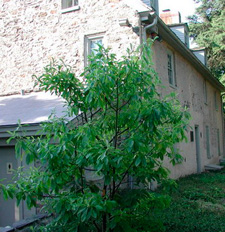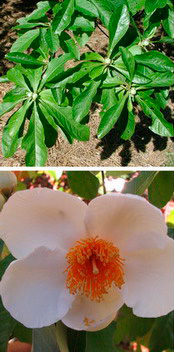Resource Library
Plant of the Week: Franklinia
The University of Arkansas System Division of Agriculture does not promote, support or recommend plants featured in "Plant of the Week." Please consult your local Extension office for plants suitable for your region.
Plant of the Week
Franklinia

All plants have a story to tell but few have a more interesting tale than Mr. Franklin’s tree, Franklinia alatamaha. This small, fall-flowering tree tells tales of environmental epochs, of wars and revolution, of extinction and resurrection.
Franklinia, named to honor Benjamin Franklin, is a member of the tea family and shares close kinship with camellias, Cleyera, Gordonia and Stewartia. It’s a low-branched, deciduous, spreading tree reaching 20 feet in height and spread. Older plants produce a striped trunk with gray-green fissures, which are especially effective in the winter landscape.
The 5- to 6-inch long spatulate leaves taper gradually to a narrow petiole and are usually clustered at the end of a branch. In the summer, they’re a deep glossy green; in the fall they turn a rich red-orange to purple and persist until the first hard freeze.
In August and September, the marble-sized flower buds swell into 3-inch wide snow white, cup-shaped flowers with five petals. In the center of the field of petals, is a cluster of numerous orange stamens surrounding a prominent protruding pistil.
Franklinia was discovered along the Alatamaha River in southeastern Georgia by John and William Bartram in 1765 as they made a plant collecting foray through that part of the country. Five years later, William collected seeds and introduced the tree to his father’s garden along the Schuylkill River across from downtown Philadelphia. All the Franklinia trees now grown in gardens around the world are descendents of the trees sent back to Philadelphia.

The Bartrams, especially John (1699 - 1777), are as close to botanical royalty as America will ever have. He was a self-taught botanist who started the first botanical garden in the New World in 1728. In 1733, he began collecting and shipping plants to patrons in the Old World. His letters are preserved in The Correspondence of John Bartram, 1734 - 1777. In 1765, King George III named him botanist to the colonies.
William (1739 - 1823) was infected by the natural history bug like his father. The two Quakers made many collecting forays from New York to Florida and were the source for most of the New World plants introduced to European gardens during the 18th century. William made a name for himself by publishing his Travels in 1791 which described his collecting trips through the southeastern states.
Though extinct in the wild, Franklinia has fared well in cultivation. In 1999, to commemorate the 300th birthday of John, the Bartram Garden launched a worldwide survey to determine the number of Franklinias being grown. Survey results discovered over 2,000 specimens in 36 states and 10 foreign countries. The greatest concentration of trees was in the New York to North Carolina region with Pennsylvania having the most trees, over 550.
In its native Georgia, there were over 50 trees, but Mike Dirr of Athens says the tree in the South is “somewhat akin to a fickle lover and may stay around and tease with its beauty, or simply leave.” Arkansas at the time had a dozen trees. Speculation that the short life expectancy for Franklinia in much of the southeastern Piedmont region is due to the presence of a cotton root rot disease (Phytophthora cinnamoni), which now contaminates much of the ground where this quintessential southern crop was grown.
Franklinia has a well-deserved reputation for being difficult to grow. It’s best in full sun in northern areas, but in the South, it should have protection from afternoon sun. It’s sensitive to poor drainage and drought, so the soil must be well drained but never allowed to get too dry. It does best with a soil pH between 5.0 and 6.0. Incorporating large amounts of organic matter helps. After planting, mulch lightly over the entire area and reapply as necessary. Success is best using container grown specimens. Franklinia is hardy from zones 5 to 9 but is easiest to grow in zones 6 and 7.
By: Gerald Klingaman, retired
Extension Horticulturist - Ornamentals
Extension News - October 26, 2007
The University of Arkansas System Division of Agriculture does not maintain lists of retail outlets where these plants can be purchased. Please check your local nursery or other retail outlets to ask about the availability of these plants for your growing area.